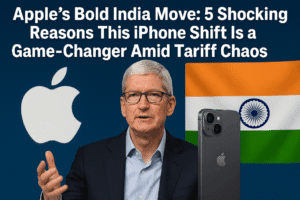Apple’s Bold India Move: 5 Shocking Reasons This iPhone Shift Is a Game-Changer Amid Tariff Chaos
Facing potential 145% U.S. tariffs on Chinese-made electronics, Apple CEO Tim Cook revealed plans to shift most iPhone production for the U.S. market to India—a strategic move to mitigate $900 million in projected tariff costs. While Apple’s recent quarterly earnings (Q1 2024) showed resilience—profits up 4.8% to $24.78 billion—the looming tariffs triggered a U.S. consumer rush to buy iPhones ahead of price hikes, with sales spikes expected to reflect in April-June results. Cook, who previously shielded Apple from tariffs during Trump’s first term, now confronts tougher geopolitical headwinds, making supply chain diversification critical.
India’s manufacturing incentives and Apple’s partnerships with Tata and Foxconn aim to address this, though challenges like infrastructure gaps and quality control persist. The shift aligns with a global “China+1” strategy, reducing reliance on Chinese manufacturing amid trade wars. For India, this signals a chance to boost tech-sector growth, while Apple risks short-term supply disruptions to safeguard long-term pricing and market stability. The move underscores how trade wars are rewriting corporate supply chain rules, blending economic pragmatism with geopolitical survival.

Apple’s Bold India Move: 5 Shocking Reasons This iPhone Shift Is a Game-Changer Amid Tariff Chaos
In a significant strategic shift, Apple CEO Tim Cook announced that a majority of iPhones sold in the U.S. will soon be manufactured in India, signaling a bold response to escalating trade tensions between the U.S. and China. The move comes as Washington prepares to impose steep tariffs—up to 145%—on Chinese-made electronics, including iPhones, a policy revival from the Trump era that could cost Apple nearly $900 million.
Why India? The Tariff Tightrope
With over 90% of iPhones currently produced in China, Apple’s reliance on Chinese manufacturing has long been a vulnerability. The proposed tariffs, part of a renewed U.S.-China trade war, threaten to inflate iPhone prices dramatically, squeezing both Apple’s margins and consumer demand. By pivoting to India, Apple aims to sidestep these penalties while diversifying its supply chain—a lesson learned after pandemic-era disruptions exposed the risks of overconcentration in one region.
India, eager to position itself as a global manufacturing hub, has rolled out incentives for foreign tech companies, including tax breaks and infrastructure support. Apple’s existing partnerships with Indian suppliers like Tata Group and Foxconn’s expanded facilities in Tamil Nadu underscore this transition. However, scaling production to meet U.S. demand won’t be seamless. Challenges such as supply chain bottlenecks, labor skill gaps, and quality control remain hurdles Apple must navigate.
Consumer Rush and Financial Resilience
The tariff announcement triggered a surge in U.S. iPhone sales as consumers scrambled to avoid anticipated price hikes. While this boost won’t reflect in earnings until the April-June quarter, Apple’s recent Q1 results (ending March 2024) already showcased resilience: a 4.8% profit rise to $24.78 billion and a 5.1% revenue increase to $95.36 billion. Cook emphasized that tariffs had minimal impact on these figures, crediting robust demand for services like Apple Pay and subscription bundles.
Diplomatic Déjà Vu for Cook
The renewed trade war places Cook in familiar territory. During Trump’s first term, his lobbying efforts successfully exempted iPhones from tariffs. Replicating that success now appears unlikely, given the broader geopolitical stakes. Instead, Apple’s India pivot reflects a pragmatic adaptation—one that aligns with Western governments’ push to reduce dependence on Chinese manufacturing.
Broader Implications: A Supply Chain Revolution?
Apple’s shift mirrors a growing trend among multinationals to adopt a “China+1” strategy, balancing cost efficiency with geopolitical risk mitigation. For India, this move could catalyze job creation and technological advancement, though questions linger about its capacity to match China’s scale and efficiency. For consumers, the transition may stabilize U.S. iPhone prices in the long term but could introduce short-term supply hiccups.
The Road Ahead
While Apple’s India gambit mitigates immediate tariff risks, it underscores a deeper reality: global trade wars are reshaping corporate playbooks. Cook’s challenge now is to ensure this transition doesn’t compromise the seamless quality synonymous with the iPhone brand. As geopolitical winds continue to shift, Apple’s ability to innovate—both in products and supply chain strategy—will define its future in an increasingly fragmented world.
For investors and consumers alike, the message is clear: Apple’s bet on India is more than a tariff dodge—it’s a high-stakes recalibration of global tech manufacturing. The success of this move could set a precedent for how multinationals navigate an era of economic nationalism.
You must be logged in to post a comment.